SUBJECTS
GRADE
Show Results
Beauty Beside Me
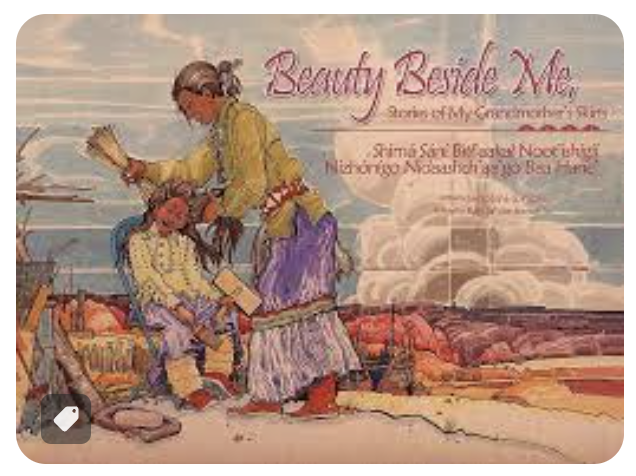
Lesson Summary
- Read the book Beauty Beside Me: Stories of My Grandmother’s Skirts
- Explore dance elements: body, energy, space and time
- Learn more about Diné /Navajo culture
Lesson Plan and Procedure
Lesson Key Facts
- Grade(s): K, 1, 2, 3, 4, 5
- Subject(s): Dance, English Language Arts, Social Studies, Native American, Tribe Approved
- Duration of lesson: 30-45 minutes
- Author(s): Erika Yellowhair, Brenda Beyal, Brenda Whitehorse
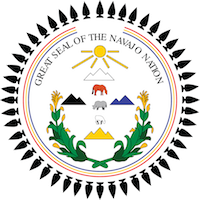
The Navajo Nation selected this lesson content in answer to the question, “What would you like the students of Utah to know about you?” Brenda Whitehorse, Heritage Language Director at San Juan School District, and representatives of the Department of Diné Education; Jamey A. Lowrey, Verna Thomas, Dorthea Litson, Johanson Phillips and Dr. Maria D. Carmen-Moffett represented the Navajo Nation in crafting the lesson to provide expertise, accuracy, and authenticity. The lesson was then approved by the Office of the President of the Navajo Nation and the Nation’s 2023 School Board.
Before teaching this lesson, please explain to your students that while there are many Native tribes in the United States, this lesson specifically focuses on experiences of the Navajo Nation and does not represent other Indigenous groups, unless specifically identified. We hope other Native tribes will honor the Navajo Nation’s decision to share this part of their history with the students of Utah.
Experience/ Identify
Read Beauty Beside Me: Stories of My Grandmother’s Skirts, by Seraphine G. Yazzie to the students. Chose an attention signal to focus the class after each movement experience and practice it with the students.
Explore/ Investigate
There are ten movement experiences to choose from. Each experience shares information to enrich students’ understanding of Navajo/Diné cultural ways. Teach a couple or all the movement experiences. Read the page or at least the first and last two sentences of each page of the book as you go through each movement experience.
Review safety concerns and expectations. To begin, have students stand and spread throughout the space. They will need to have enough room to lengthen their limbs to their fullest.
Review the attention signal with the class.
Teacher: The following transition movement follows the attention signal we have practiced. When I say, “[the] skirt swayed back and forth, back and forth,” sway back and forth to represent the movement of material (fabric), followed by a slow spin to a new location in the room. Let’s practice.
Practice the attention signal with the transition movement by giving the attention signal followed by, “[the] skirt swayed back and forth, back and forth.”
Teacher: The story shares with us what Grandmother did while wearing a specific color of skirt, today we will explore through movement some of the activities.
Activity One: Yellow- making fry bread
Navajo Vocabulary:
Fry bread: Dah diníilghaazh
Delicious: Łikan
Read page 3 (yellow) or at least the first and last two sentences.
Background Knowledge:
In the book, Grandma makes fry bread when wearing her yellow skirt. Fry bread is a bread that the Diné make out of flour, salt, and baking powder. In 1864 the Diné were forced to live in an internment camp (Bosque Redondo) in east-central New Mexico. They were given the ingredients listed above as food rations. At first, the Diné would only eat the flour plain. Eventually, through experimentation, they learned that mixing all the ingredients would create a sticky dough. The dough was patted out into a pancake shape and fried. It made a delicious bread they named fry bread- Dah diníilghaazh. In order to shape the fry bread dough, you have to pat it back and forth to help it become a flat, thin circle. Today fry bread has become a staple at Native American gatherings across the United States.
Here are two videos to learn more about fry bread and the Long Walk:
- Cooking Fry Bread, is a video that shows how fry bread is made. Watch the first minute of the video
- The Long Walk
Teacher: When Grandmother wore her yellow skirt she cooked and made fry bread. Using our bodies let’s go through the process of making fry bread.
Use the music, Fry Bread by Conner Chee or a hand drum to keep the beat. Explore the following movements with your students so they have an example to follow.
Teacher: First, we put the ingredients into our bowl, flour, salt, baking powder and water. Make a curved shape with one of your arms and use the other to put the ingredients in using exaggerated arm movements.
Teacher: Next it’s time to mix and knead the ingredients into a soft dough. Use your body to show how the dough is mixed, stretched, pulled, and kneaded. Stay in one place and use big movements to knead the dough.
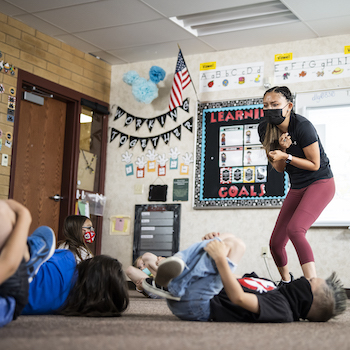
Teacher: It’s time to roll the dough into small balls. Let’s all gather together to make a large group shape to represent the dough. You can connect by placing your hand on someone's shoulder, connecting your shoe to someone else's shoe, placing your shoulder against someone’s back, etc. When I call your birth month, break away from the class shape and roll away into your own dough ball. Explore 3-5 unique ways of rolling before freezing in a ball-like shape in a new place in the room.
Teacher: Time to pat the dough out in a round flat shape. Everyone, pat your hands back and forth to make the fry bread. Alternate their top hands as they pat. For example, pat with their right hand on top, then their left hand on top, and repeat. Pat your hands together in a circle shape, now in a big circle shape. Finally, it’s time to put the dough in hot oil. Gently place the dough in hot oil and listen to it sizzle! Show me sizzle with your body using vibratory energy which includes movements that flicker, thrash, quiver, shudder and fluctuate. It is now time to slow down, sit and eat the fry bread. Have students sit on the floor and show eating their fry bread.
Give the attention signal followed by prompting the transition movement by saying, “[the] skirt swayed back and forth, back and forth.
Activity Two: Green- Planting
Navajo Vocabulary:
Corn Naadą́ą́'
Squash Naayízí
Read page 6 (green) or at least the first and last two sentences.
Background Knowledge:
In the book grandma plants seeds. The Diné /Navajo began farming years ago. Though many tribes were hunters and gatherers, the Navajo utilized dry farming to grow food staples. Today the Diné continue to have small gardens. Many grow beans, corn, and squash known as the three sisters.
Here are two videos to learn more about the three sisters.
Teacher: When Grandmother wore a green skirt she planted beans, corn, and squash which are sometimes called the three sisters.
Use the music, Corn Grinding Song No. 2 by Conner Chee or a hand drum to keep the beat.
Teacher: The corn grew tall, the beans used the corn stalks as support and the squash grew near the ground crowding out weeds so all three could flourish. Other fruits and vegetables, like watermelon, were also grown. Carry your seeds and skip around the room and listen for my voice to say, “plant,” which stands for stooping low to the floor to drop seeds onto the desert ground. What different low shapes can you make with your body as you stoop low? Continue to travel around and listen for my voice to plant seeds anywhere you want in the dance space.
Using eight counts have the students skip for seven and then plant on the eighth. A hand drum is an excellent way to keep count.
Teacher: Freeze! Watermelon and squash spread out on the ground as they grow. Using your whole body, get close to the floor, and show the vines of the watermelon or squash spreading on the ground. Stay stationary, in one place, and do some axial movements, which are movements done while staying in one spot. Stretch, bend, flex, jerk, lift, extend, raise and lengthen (give students 30 seconds to move). Freeze! Corn rises up from the ground and grows straight up to the sky. Can you embody corn? Stay in one spot and get as small as possible like a tiny corn seed and then slowly grow until you are as tall as you can get reaching high up just like a corn stalk. Once you are as high as you can go, freeze in an interesting tall corn stalk shape.
Give the attention signal followed by prompting the transition movement by saying, “[the] skirt swayed back and forth, back and forth.”
Activity Three: Purple-Weaving
Navajo Vocabulary:
Sheep Dibé
Rug Diyogí
Read page 7 (purple) or at least the first and last two sentences.
Background Knowledge:
Rug weaving is important to the Navajo. Just like a painting or a drawing, the weavings tell stories. Navajos use a loom they make from the wood around them. They make the yarn threads from the wool of the sheep they own. There are many geometric designs that are unique to a location on the Navajo Nation. The warp are the stationary vertical yarn threads that create the structure and keep the tension for the yarn, the weft, to be woven in and out of to make the rug. There are both male and female Diné weavers today.
Here is a video that shows the process of rug weaving:
Teacher: When Grandmother wore a purple skirt she wove a rug.
Use the music, Navajo Vocable for Piano No. 4 by Connor Chee or a hand drum to keep the beat.
Teacher: One half of the class will stand in a line arms-length apart. The other half will follow me as we weave in and out of the students standing still. This represents weft threads being woven in and out of the warp strings of a loom. (Divide the class in half and have one-half of the students stand in a line arms-length apart. Have the other half follow you as you weave in and out of the line the students have made.) As you weave in and out, allow one arm to lead you in and out imagining it to be the weft thread being woven into a beautiful rug. (When one half has gone through, have students change places and lead the other half of students through the new “warp” line of students.)
Give the attention signal followed by prompting the transition movement by saying, “[the] skirt swayed back and forth, back and forth.”
Activity Four: Orange–Herbs, picking Navajo tea
Navajo Vocabulary:
Navajo tea Dééh
Plant Ch'il
Read page 10 (orange) or at least the first and last two sentences.
Background Knowledge:
Navajo tea is a traditional drink made from a plant most commonly known as Green thread or Thelesperma. It is a perennial bulb that blooms from May to September. When harvested, it is snapped low to the stem, keeping the roots intact, then shaken to release the seeds back to the earth so the life cycle continues. The stems are folded into tiny bundles and then hung to dry. When a bundle is boiled, its tea can be sweetened with honey or sugar before it is consumed. The Navajos have used this tea for centuries to alleviate joint pain, calm upset stomachs, and boost the immune system.
Here is a video to learn more about Navajo tea.
Teacher: When grandmother wore her orange skirt she picked Navajo tea which is a plant commonly known as Green thread. For this movement activity, we will shadow partners. On the count of three, stand facing a partner. Decide who will go first. As soon as I say the movement word, partner one begins to move in the way the word inspires them to move, partner two then begins to copy-cat whatever partner one is doing just like they are the shadow. When I say “freeze,” freeze in an interesting shape. Then switch roles for the new word.
Use the music, Suen’s Work Song by Delphine Tsinajinnie or a hand drum to keep the beat:
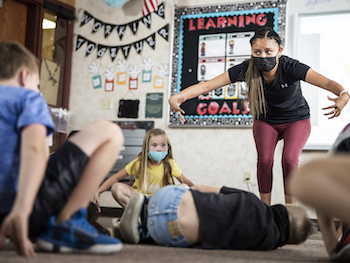
First word, “bloom.” Green thread is a perennial bulb that blooms from May to September. Give students time to explore movements that come to their minds when they think of the word bloom. Freeze! New word, “snaps!” When grandmother harvests Green Thread she snaps the plant stem near the ground, keeping the roots intact. Give students time to explore movements that come to their minds. Freeze! New word, “shake!” Grandmother takes the harvested plant and shakes it to release the seeds back to the earth so the life cycle continues. Give
students time to explore movements that come to their minds. Freeze! New word, “folded!” The stems are folded into tiny bundles to dry. Give students time to explore movements that come to their minds. Freeze!
Teacher: When a bundle is boiled, the tea can be sweetened with honey or sugar before it is consumed. The Navajos have used this tea for centuries to alleviate joint pain, calm upset stomachs, and boost the immune system.
Give the attention signal followed by prompting the transition movement by saying, “[the] skirt swayed back and forth, back and forth.”
Activity Five: White- Pinons
Navajo Vocabulary:
Pinon neeshch’íí’
Food ch’iyáán
Read page 12 (white) or at least the first and last two sentences.
Background Knowledge:
Pinon nuts grow in pinecones on small pine (pinyon) trees that grow in the southwest. Most often they can be found growing near juniper trees. Pinyon trees grow all over the Navajo Nation and are a traditional food of the Diné. When pinecones open up and expand they release nuts that fall to the ground. The Diné pick up the pinon seeds, clean them and roast them without shelling them. They can be eaten like sunflower seeds. It is a great source of protein.
Here are two videos to learn more about pinons.
Teacher: When grandmother wore her white skirt she picked pinons. They are the seeds held in pine cones from a pinon tree. The pinecones slowly begin to grow bigger and bigger.
Use the music Fire Dance (Native American Flute), by Rensmusic or a hand drum to keep the beat. You will need to download the music to use it for this movement activity.
Teacher: Let’s start low to the ground and make ourselves as small as possible and then begin to grow bigger and bigger until we are as big as we can possibly make our bodies. Pinecones can open and close, they open when it’s dry and close when it’s wet. When I say “wet,” fold into the center of your body, your core, which is the center of your belly button and then when I say “dry,” move away from your core (distal movement), stretching as wide as possible. Let’s do that several times. When the pinecone is fully developed and open that is when the pinon nuts fall to the ground. Let’s keep doing our core/distal, wet/dry movements and when I say collapse, slowly collapse your body to the floor like a seed being released from a pine cone.
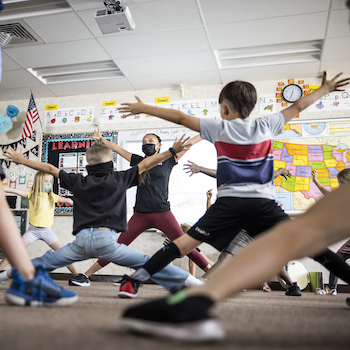
Do the core/distal movement using the terms wet/dry several times and then have the students collapse to the floor.
Give the attention signal followed by prompting the transition movement by saying, “[the] skirt swayed back and forth, back and forth.”
Activity Six: Red- Sheep Herding
Read page 13 (red) or at least the first and last two sentences.
Background Knowledge:
Sheep are essential livestock of Navajo culture. Not only do they provide meat but their wool is used to create beautiful rugs for trading and traditional regalia for special occasions. Today many members of the Navajo Nation continue to raise sheep. Sheep owners take the sheep out to graze everyday. To take care of the land, the sheep will be rotated through grazing areas so the earth has time to replenish. Sheepherders usually walk behind and on the perimeter of the herd to guide them in a particular direction.
Here is a video to learn more about sheep herding.
Teacher: When Grandmother wore her red shirt she herded sheep. Today we will practice locomotor movements representing a sheep grazing.
Use the music, Sheep by Connor Chee or a hand drum to keep the beat.
Teacher: Let’s start walking around the room, changing your direction when I say, “change.”
Have students walk and change directions when you say the words.
Teacher: Many members of the Navajo Nation continue to raise sheep. They take the herd out of the corral everyday to graze. As the sheep leave the corral they will walk and get ready for the day’s adventures. Continue walking and shaking out the kinks and tightness from your body. As the sheep loosen up, they will sometimes run. They are very good at running and not bumping into each other. Let's run in the space, making sure we are aware of others, remember to change directions when I say the word, “change.” When I say, “freeze,” stop and freeze.
Have students run, change directions and freeze.
Teacher: A sheep search for water sources they will sometimes leap over rocks, branches and bushes. Let’s practice leaping. Have students practice leaping, changing and then freezing.
Teacher: Sheep will eat plants low to the ground and sometimes eat leaves high up on trees. Move low to the floor and then when I say “jump,” jump high up and then come back down low to the floor and continue moving low to the floor.
Have students practice the locomotor movements (walking, running, leaping, jumping) as you say them out loud.
Give the attention signal followed by prompting the transition movement by saying, “[the] skirt swayed back and forth, back and forth.”
Activity Seven: Brown- Cedar Beads
Navajo Vocabulary:
Juniper gad
Ant woláchíí
Read page 16 (brown) or at least the first and last two sentences.
Background Knowledge:
Cedar beads are actually dried juniper berries. The juniper berries fall to the ground from the juniper tree and dry up naturally. As they are drying, ants eat through one end creating a hole. The dried juniper berries are picked up off the ground and collected. The bead is created by putting a hole through the end that the ants did not eat through. They signify the connection between trees, animals, the earth, and humans. They are also thought to bring peace, safety, and harmony to the wearer. The beads are also known as ghost beads and are thought to keep evil spirits away. They can be seen on top of children’s cradleboards or cribs being used to chase off bad dreams. Traditionally, the cedar beads have four other smaller beads strung between them in the necklace or bracelet; in present day more modern designs have strayed away from the tradition.
Here is a video
- Navajo Historian Wally Brown Teaches About Ghost Beads
- How to Make Juniper Berry Ghost Beads for Protection, Peace, Beauty, Balance,
and Harmony. Hozho
Teacher: When Grandmother wears a brown skirt she collects cedar beads, also known as “ghost beads”, and makes jewelry. The beads are said to bring harmony, peace and safety to the wearer.
Use the music, The Swallows by Connor Chee or a hand drum to keep the beat.
Teacher: Let’s stand in a circle, arms length apart to represent a cedar bead necklace. The cedar bead is usually strung after three seed beads. Let’s start moving through the space for 8 counts. When I count to 4, make an explosive movement to represent the cedar bead and then resume walking until the 8th count when you will again make an explosive movement. Accent the 4th and 8th count any way you wish, just making sure it is full of energy. Be mindful of the person in front and behind you. Have students begin walking to your count and then on the 4th beat make an explosive movement and then again on the 8th.
Give the attention signal followed by prompting the transition movement by saying, “[the] skirt swayed back and forth, back and forth.”
Activity Eight: Turquoise- town
Navajo Vocabulary:
Road atiin
Town kin shijaaʼ
Read page 18 (turquoise) or at least the first and last two sentences.
Background Knowledge:
Many Navajos live in small communities and towns on the Navajo Nation while others live in even more remote places where it takes miles to get to a grocery store to buy supplies. A trip to town can take anywhere from 1-4 hours one way. Some have to travel on different types of roads including dirt roads and highways. This may be a new concept for your students, so take the time to explain that dirt roads are roads that have not been paved that are made solely of dirt. When it rains on these dirt roads all of the small pebbles of rock come to the surface and it feels as if you are driving on a washboard. A washboard is extremely bumpy and it feels like you are continually going over a series of speed bumps.
Teacher: When Grandmother wore her turquoise skirt she drove her truck to town to get supplies.
Use the music, Buy A Vehicle by Radmilla Cody or a hand drum to keep the beat.
Teacher: Start walking and change direction investigating different pathways as if you too are on your way in your own vehicle. Some roads are paved and smooth so it seems as though you are gliding over them. Show me gliding using smooth, effortless movements as you move across the room. Your movements should be continuous. Can you change glide at a low level? A medium level? Can you change levels as you move? Freeze!
Take time to notice the different freezing poses. Have students relax and turn their attention to you.
Teacher: Sometimes as people travel they have to drive on dirt roads which makes the journey very different from being on a paved roadway. Speeds are much slower and more bumpy. Begin moving through the space by skipping. How about skipping in a curved pathway? Can you slow down your skip as if to slow down the vehicle because of very bumpy patches in the road? Don’t forget to explore different pathways. Freeze! Sometimes parts of a dirt road are called a washboard, which means that you have to go over continuous ripples of dirt mounds. When it rains all of the small pebbles of rock come to the surface making travel extremely bumpy. It feels as if you are continually going over a series of speed bumps. Let’s investigate traveling on a washboard road by jiggling our bodies as we move through the space. Jiggling means to move our bodies lightly and quickly up and down or side to side much like a bowl of jello. Work to make your whole body a part of the jiggling movement. Are your fingers a part of the jiggling movement? How about your head, shoulders, hips, legs? Remember to move through the space changing your levels. Freeze! Relax.
If time permits, continue having students explore and move according to your directions.
Give the attention signal followed by prompting the transition movement by saying, “[the]skirt swayed back and forth, back and forth.”
Activity Nine: Gray- sleep
Navajo Vocabulary:
Baby Awéé'
Song sin
Read page 20 (gray) or at least the first and last two sentences.
Background Knowledge:
Singing is an integral part of Navajo life. There are ceremonial songs that are considered a form of prayer, social songs sung at gatherings, and many other songs sung at different occasions and times. One specific type of song is baby songs sung to and with young children. The grandmother in the story held the baby in her lap, but other Navajo mothers use cradleboards to hold their babies. Cradleboards are still used today, they are protective carriers made out of pine or cottonwood. The two backboards represent Mother Earth and Father Sky. Another board is arched above the baby’s head to represent a rainbow. In addition, this arch serves as a safety measure and is also used to hang small toys to keep the baby occupied.
Teacher: When Grandma wore a grey skirt she sang lullabies and put babies to sleep.
Use the music, Navajo Lullaby: “Shii Na-Sha” by Julia Begaye or a hand drum to keep the beat.
Teacher: Begin moving through the space to the tempo of the music. Use sustained movements which are continuous flowing motions while rocking, swaying and swinging, . . . move your arms . . . now move your legs, moving them through the space in a smooth motion. . . Can you spin slowly and smoothly as you move?
Spend a few minutes having students explore sustained movements while moving to the tempo of the music.
Give the attention signal followed by prompting the transition movement by saying, “[the] skirt swayed back and forth, back and forth.”
Activity Ten: Black- fire
Navajo Vocabulary:
Home hooghan
Fire kǫʼ
Read page 23 (black) or at least the first and last two sentences.
Background Knowledge
Fire is always at the center of a traditional Navajo home called a hogan. It is at the center because it represents the heart of the home. Many homes on the Navajo Nation have a wood stove that they use as a main source of heating during the winter. For people on the Navajo Nation who do not have running water or electricity they use fire stoves to cook their food and keep warm. These families must prepare through the summer by gathering wood and storing it for the winter months.
Teacher: When Grandma wore a black skirt she lit a fire.
Use the music Fire Dance (Native American Flute), by Rensmusic or a hand drum to keep the beat. You will need to download the music to use it for this movement activity. Think of how a flame moves, sometimes it sways, twists, and flickers in the same place. Move using axial movements by twisting and swaying your arms while staying in one spot. Fire starts with a small flame that begins to flicker because of high heat. Make your body as small as possible and use percussive movements to indicate high heat is beginning to start a fire. As the wood begins to burn, the flicker starts to grow into a small flame. Move to a medium level and embody a small flame. As more energy is released, the flame grows even bigger. Explore movements performed at a high level that you feel resembles a vibrant fire.
Spend a few minutes exploring axial, percussive, sustained movements. If available, hand each student a ribbon or strip of cloth to explore movements a fire might make.
Give the attention signal followed by prompting the transition movement by saying, “[the]
skirt swayed back and forth, back and forth.”
Activity Eleven: Blue- Song and Dance
Read page 22 (blue) or at least the first and last two sentences.
Background Knowledge:
Song and Dance evolved from a ceremony called Nidaa' or Enemy Way Ceremony. Song and Dance is a social dance between a man and woman. Despite this dance presently being a social dance it should only be done during sponsored events at the proper time of year, which is during the summer. The Navajo Nation Department of Dine Education has asked that we do not teach about this dance so we respectfully follow their guidance and ask that the following statement be made.
Teacher: When Grandma wore a blue skirt she danced Song and Dance. Song and Dance is a dance that stems from a ceremony and participated in during sponsored events, for this reason we will not be investigating Song and Dance.
Create/ Perform
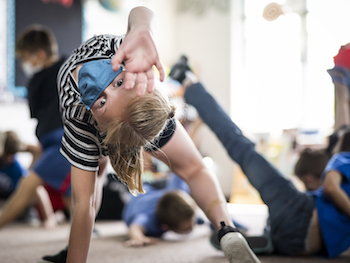
Choose one of the following activities to create and perform:
- Teacher: We are going to create our own dance to connect us all together by each of us adding a dance movement to the dance. We are creating our own movements to represent our individual uniqueness and the sociality that comes from dancing. I will start with my personal movement. (demonstrate a dance move.) Copy me. Turn to the student to your left. What is your dance move? The student will show their dance movement. Great! Let’s do my dance movement and add (student’s name) dance to mine. Go around the circle adding all the students’ dance movements making a class dance.
- The last page in the book shares how the granddaughter now wears skirts like her grandmother because they remind her of her grandmother’s knowledge, wisdom and love. Have the students think about someone in their family that shares their wisdom, knowledge and love through actions like the grandmother in the book. Divide the class into groups of three. Have each student choose a movement that embodies the teaching of the family member they chose and demonstrate it in eight counts. Each group will create a dance with all three movements divided by the transition by swaying back and forth and spinning done in four counts. Have students practice their group dance and then have each group share their dance with the rest of the class.
Connect/ Analyze
At the conclusion of the lesson, hold a discussion about the book:
- What new knowledge did you gain about Navajo culture or lifestyle? Share with your neighbor. Choose one or two students to share with the whole class.
- What would you like to know more about?
- Which part of the book is most like your own life?
- What did we learn about the grandmother and granddaughters relationship? How is it different or similar to your relationship with an older adult in your life?
Learning Objectives
- Understand the story Beauty Beside Me: Stories of My Grandmother’s Skirts by exploring and responding to movement commands that relate to the plot, characters, and events that take place in the story.
- Listen to the story, follow movement instructions, participate enthusiastically in the dance, respect other students by keeping a safe distance from each other, and not judge other students.
Utah State Board of Education Standards
This lesson can be used to meet standards in many grades and subject areas. We will highlight one grade’s standards to give an example of application.
Grade 2 English Language Arts
- Standard 2.R.6: Read a variety of texts including those from diverse cultures, retell the narrative (RL) or informational text (RI) according to the text structure including the main idea.
- Standard 2.SL.2: Speak clearly and audibly while asking and answering questions about a topic and key details.
- Standard 2.SL.3: Use age-appropriate language, grammar, volume, and clear pronunciation when speaking or presenting.
- Present information, stories, or opinions, sequencing ideas logically and use descriptions, facts, and details.
Grade 2 Dance
- Strand: CREATE (2.D.CR.): Students will conceptualize, generate, develop and organize artistic ideas and work. They will complete and refine dance works (Standards 2.D.CR.1–4).
- Standard 2.D.CR.1:Demonstrate willingness to work with partners when creating dance.
- Standard 2.D.CR.2: Explore movement inspired by a variety of stimuli.
- Strand: PERFORM (2.D.P.): Students will analyze, interpret, and select artistic work for performance. They will develop techniques and concepts to refine artistic work and express meaning through the presentation of dance works (Standards 2.D.P.1–7).
- Standard 2.D.P.1: Move safely in general space through a range of activities and group formations while maintaining personal space.
- Standard 2.D.P.6: Demonstrate a variety of movement qualities while dancing.
Grade 3 Social Studies
- Standard 3.4.1: Choose a community outside of the United States. Locate that community on both print and digital maps of the Earth, their continent, country, and city or town, and contrast their sizes and the relationships in scale.
- Standard 3.4.3: Define the cultures of the community they chose in 3.4.1 (for example, art, music, food, dance, system of writing, architecture, government, religion).
- Standard 3.2.3: Define their own cultures or the cultures of their communities (for example, art, music, food, dance, system of writing, architecture, government to which they are regularly exposed or of which they are part).
Diné Standards
This lesson can be used to meet many Diné standards. The following are examples of application.
Pre K-3rd Diné Character Building Standards
- Standard: K’é hwiinidzin dóó ádáhozdílzin bee hadínísht’é e dooleełígíí bó hwiideesh’ááł.
I will develop and apply critical thinking to establish relationships with the
environment.- Concept 1: K’e.zhnídzin dooleeeł.
I will express critical thinking to establish relationships with the
environment- PO 2. Shizhé ’é dóó shimá dóó bił háíjéé ’ baa ahxéé h nisin
dooleeł.
I will respect my immediate family.
- PO 2. Shizhé ’é dóó shimá dóó bił háíjéé ’ baa ahxéé h nisin
- Concept 1: K’e.zhnídzin dooleeeł.
- Concept 2: Á dáhozdílzin dooleeł.
I will practice and maintain the sacredness of self-identity.- PO 1. Í inísts’ą́́ą’go na’nitin baa ákonisin dooleeł.
I will listen and observe cultural teachings. - PO 3. Hooghan haz’ą́́ągi na’nitin baa ákonisin dooleeł.
I will identify the teaching of home life.
- PO 1. Í inísts’ą́́ą’go na’nitin baa ákonisin dooleeł.
- Concept 4: T’áá ałtsoní baa ahéé hwiindzin.
I will understand and appreciate all things.- PO 4. Shimásání dóó shicheii baa hane’ bits’ą́́ą́́dóó
íhwiideesh’ááł.
I will express and value my grandparent’s Diné way of life
teaching.
- PO 4. Shimásání dóó shicheii baa hane’ bits’ą́́ą́́dóó
Pre K-3rd Diné Culture Standards
- Standard: K’é dóó nitsáhákees dóó nahat’á náásgóó iiná bee siih hasingo
ádoolnííl. I will develop an understanding of Diné way of life.- Concept 1: Nitsáhákees
Shintsáhákees shił nilį́́į go bee ádaa’ákonisdzin dooleeł.
I will acknowledge and value my thoughts and personality.- PO 2. Yó dí ałtaas’é í choosh’ínígíí baa hą́́ą́́h nisin dooleeł.
I will describe the value of things that I use. - PO 3. Nitł’iz ałtaas’é í baa a’konisin dooleeł.
I will recognize cultural items and jewelry.
- PO 2. Yó dí ałtaas’é í choosh’ínígíí baa hą́́ą́́h nisin dooleeł.
- Concept 1: Nitsáhákees
Equipment and Materials Needed
- Colored Paper (Yellow, Green, Purple, Orange, White, Red, Brown, Turquoise, Gray, Blue, Black)
- Beauty Beside Me: Stories of My Grandmother’s Skirts, By Seraphine G. Yazzie (Salina Bookshelf link)
- Ribbons or strips of fabric (optional)
Additional Resources
This lesson was created thanks to a grant from the National Endowment for the Arts and the Utah Division of Arts & Museums.
https://www.navajo-nsn.gov/
https://www.navajonationdode.org/
https://media.sjsd.org/
https://mpc.byu.edu/education-resources
BYU MSS Celebration of Native American Cultures 2021: Frybread Tutorial and
History https://www.youtube.com/watch?v=isdHC5nMQT8 (History 32:17;
Tutorial 33:41; Frybread Results 38:36)
Image References
Image 1: https://www.amazon.com/-/es/Beauty-Beside-Me-Stories-Grandmothers/dp/1893354075
Image 2: https://en.wikipedia.org/wiki/Navajo_Nation_Council
Image 3-6: Brenda Beyal
© Brigham Young University and Navajo Nation Department of Diné Education

www.education.byu.edu/arts/lessons
 Download
Download